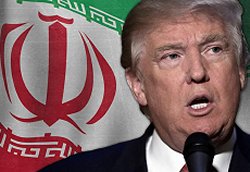
|
- Iran: Eight Prisoners Hanged on Drug Charges
- Daughter of late Iranian president jailed for ‘spreading lies’ - IRAN: Annual report on the death penalty 2016 - Taheri Facing the Death Penalty Again - Dedicated team seeking return of missing agent in Iran - Iran Arrests 2, Seizes Bibles During Catholic Crackdown
- Trump to welcome Netanyahu as Palestinians fear U.S. shift
- Details of Iran nuclear deal still secret as US-Tehran relations unravel - Will Trump's Next Iran Sanctions Target China's Banks? - Don’t ‘tear up’ the Iran deal. Let it fail on its own. - Iran Has Changed, But For The Worse - Iran nuclear deal ‘on life support,’ Priebus says
- Female Activist Criticizes Rouhani’s Failure to Protect Citizens
- Iran’s 1st female bodybuilder tells her story - Iranian lady becomes a Dollar Millionaire on Valentine’s Day - Two women arrested after being filmed riding motorbike in Iran - 43,000 Cases of Child Marriage in Iran - Woman Investigating Clinton Foundation Child Trafficking KILLED!
- Senior Senators, ex-US officials urge firm policy on Iran
- In backing Syria's Assad, Russia looks to outdo Iran - Six out of 10 People in France ‘Don’t Feel Safe Anywhere’ - The liberal narrative is in denial about Iran - Netanyahu urges Putin to block Iranian power corridor - Iran Poses ‘Greatest Long Term Threat’ To Mid-East Security |
Tuesday 06 December 2011AEI War Hawks Warn That Iran Poses ‘Existential Worry’Think Progress The American Enterprise Institute has a new report [PDF] outlining the challenges of containing and deterring a nuclear Iran. But while the report claims to be looking down the road to the imminent scenario of a nuclear weapons-possessing Iran, the neoconservative authors push an agenda of increased military spending justified by what they questionably claim will be a new and unparalleled containment challenge. For starters, the presumption that “sound American strategy thus requires assuming that Iran will have a weaponized nuclear capability when the next president takes office in January 2013″ manages to completely ignore most intelligence estimates about Iran’s nuclear program. AEI’s report offers no evidence of this claim. To construct a nuclear weapon by 2013 would require Iran to have already begun producing highly enriched uranium (HEU). Neither the IAEA nor any other reputable intelligence estimates have made this assertion. Moreover, Director of National Intelligence James Clapper said in February that the U.S. government believes that it would take Iran a “few years” to acquire enough HEU for one nuclear weapon, “if it chooses to do so.” Furthermore, the authors elide or downplay the existing efforts to slow Iran’s nuclear program. Five years after Iranian President Mahmoud Ahmadinejad anounnced plans to deploy a new generation of indigenous centrifuges, Iran hasn’t brought a full cascade of the devices online. Various other technical problems, including the Stuxnet computer virus, have plagued the Iranian program. None of this could have happened without the multilateral sanctions regime engineered by the White House. But harsher measures — such as those targeting the central bank — could threaten the international coalition against Iran. The rest of the report relies on repeated calls for increased defense spending — a topic near and dear to the defense hawks at AEI — and repeating the claim that Iran will be particularly difficult to contain because Iranian leadership is irrational or suicidal. Despite the factual weakness of the “martyr state” myth, the report argues: It is likely that the Iranians value nuclear weapons not only for their deterrent purposes but also, if delivered by a suicide terrorist, for the intoxicating promise of devastating effect and potential deniability. [...] Questions about the rationality or apocalyptic visions of the current clerical leadership or Ahmadinejad must be considered as a reimagining of the past. There is little evidence that Iran’s leadership is suicidal or irrational but this myth is an important argument in the toolkit for hyping fears about a nuclear Iran. It should come as no surprise that two of the report’s authors — Danielle Pletka and Thomas Donnelly — were signatories on Project for The New American Century (PNAC) letters devoted to pushing for regime change in Iraq by force. The brain trust behind the invasion of Iraq is now warning of an “existential worry” (whatever that means) to the U.S. and its allies in the region. And much like in the buildup to war with Iraq, overstating the threat and misrepresenting facts on the ground is the first step in mobilizing support for incautious militaristic foreign policies. |






